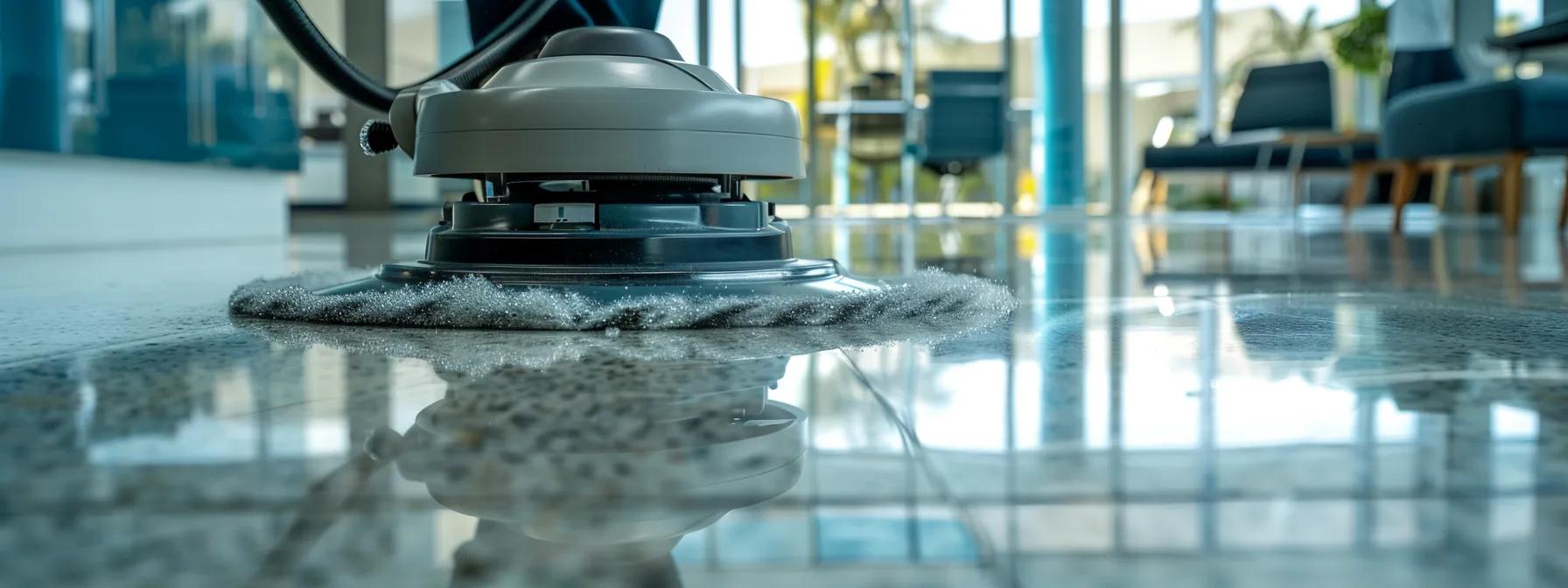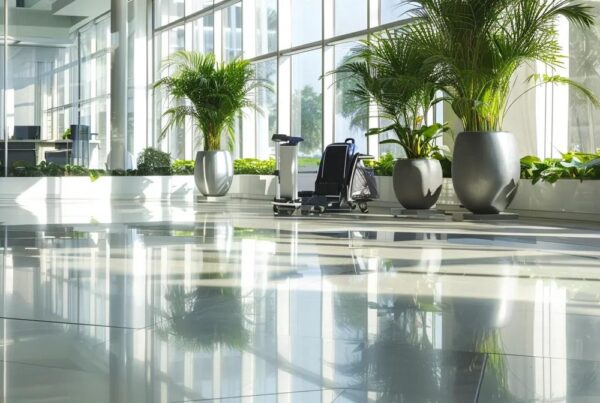Table Of Contents:
- Commercial Cleaning Benefits for a Healthier Workplace
- Benefits of a Pristine Workspace for Employee Health
- Impact of Commercial Cleaning Services on Workplace Wellbeing
- Quality Standards in Commercial Cleaning for Healthier Offices
- Cost Advantages of Maintaining a Health-Centric Workspace
- Integrating Commercial Cleaning Services With Facility Management
- Real-Life Examples of Healthier Work Environments Through Commercial Cleaning
- Conclusion
- Frequently Asked Questions
- Key Takeaways
- Final Thoughts
Commercial Cleaning Benefits for a Healthier Workplace
In today’s fast-paced commercial environment, maintaining a pristine workspace goes beyond mere aesthetics—it is a critical component of employee health and safety. With concerns ranging from the common cold to occupational safety and health signatures, commercial cleaning contracts offer significant benefits that enhance overall workplace wellbeing. Businesses across Central Florida, from office cleaning services to high-end corporate cleaning, are increasingly prioritizing cleanliness to reduce the spread of bacteria, mitigate debris and dust, and improve the indoor air quality of their facilities. The importance of environmentally friendly practices also plays a pivotal role, as modern commercial janitorial services near me focus on using sustainable cleaning agents and advanced cleaning technologies that enhance the overall health of the workspace while preserving the environment. Organizations such as Freedom Cleaning Solutions in Central Florida leverage technology and certified cleaning practices to seamlessly integrate their services with facility management programs, ensuring that each cleaning contract not only meets but exceeds industry standards. This article details the benefits of a pristine workspace for employee health, the impact of commercial cleaning services on workplace wellbeing, the quality standards in commercial cleaning, the cost advantages of a health-centric workspace, integration of cleaning services with facility management, and real-life case studies that demonstrate these benefits.
As businesses continue to battle the challenges of maintaining hygienic work environments in an era where the risk of contaminants is high, this comprehensive guide provides actionable insights supported by scientific research and industry benchmarks. Recognizing that employee productivity and retention significantly improve in healthier workspaces, the content explores how clean environments can lower sick leave, boost morale, and contribute to a more efficient organization. Transitioning from the introduction, the following sections delve deeply into each aspect of maintaining a healthy, professionally cleaned workspace, with subtopics detailing empirical evidence and real-life results that underscore the importance of commercial cleaning services in modern office management.
Benefits of a Pristine Workspace for Employee Health

Creating a pristine workspace is essential as it directly contributes to improved employee health. The first benefit is improved air quality and the reduction of allergens, which can lead to fewer respiratory issues and lower instances of allergic reactions in the workplace. Enhanced air filtration systems, along with regular cleaning of dust, debris, and microbial contaminants, work in unison to create an environment free from particulate matter that can trigger asthma and other respiratory conditions. Studies have shown that implementing comprehensive cleaning protocols can reduce indoor pollutants by up to 30% (Huang et al., 2019, link).
Improved Air Quality and Reduced Allergens
A clean workspace naturally supports better air quality by minimizing dust, microbes, and other allergens through professional cleaning methods. Regular vacuuming with HEPA filters, effective damp wiping to remove dust, and the use of environmentally friendly disinfectants reduce airborne irritants and contribute to a balanced and breathable indoor atmosphere. This improved air quality not only reduces allergy-related symptoms but also enhances workers’ concentration and energy levels. In addition, proactive measures, such as cleaning carpets and upholstery, help trap allergens that typically accumulate over time. Employees therefore benefit from fewer instances of coughing, sneezing, and other allergy symptoms, which in turn contributes to increased overall productivity.
Stress Reduction Through a Clean Environment
A clutter-free and meticulously maintained workspace has a profound effect on employee stress levels. Research in occupational safety shows that clutter and mess can elevate cortisol—the stress hormone—thereby impacting mental clarity and focus (Smith et al., 2020, link). When offices are well-organized, the aesthetic quality of the environment supports mental well-being and a sense of calm, allowing employees to focus on their tasks with minimized distractions. Beyond the physical improvement in aesthetics, there is a psychological benefit: a clean environment communicates that the organization values employee welfare, leading to reduced anxiety, enhanced mood stability, and an overall positive work atmosphere.
Lower Sick Leave and Increased Productivity
The final prime benefit lies in the measurable reduction of sick leave and the associated increase in productivity. When workspaces are routinely sanitized—reducing bacteria, viruses, and other pathogens—the spread of communicable diseases is limited. This proactive approach results in a tangible drop in sick days, as employees are less likely to contract illnesses such as the common cold. Furthermore, clean offices foster a culture of care that can translate to increased job satisfaction, reducing staff turnover rates. Numerous case studies suggest that companies that invest in top-tier cleaning services experience up to a 15% increase in productivity due to improved employee health and reduced absenteeism. These statistics underscore that investing in a healthy workspace yields long-term financial benefits along with improved workplace morale.
Impact of Commercial Cleaning Services on Workplace Wellbeing

Commercial cleaning services are crucial not only for maintaining cleanliness but also for significantly enhancing workplace wellbeing. These professional services manage sanitation consistently, ensuring that every aspect of the work environment is treated with precision to create a safe and inviting space for employees. The adoption of advanced techniques and comprehensive cleaning protocols results in improved physical safety and contributes positively to mental health. By reducing the risk of outbreaks and providing a reliable clean environment, these services support a culture of health that can lead to a more loyal and productive workforce.
Consistent Sanitation Practices
Consistent sanitation practices form the backbone of commercial cleaning contracts. Professional cleaning companies use scheduled, thorough cleanings that minimize the likelihood of dirt, debris, or pathogen build-up. This consistency prevents the accumulation of dust in high-traffic areas and ensures surfaces prone to bacterial contamination, such as door handles and breakroom tables, are regularly disinfected. In addition, maintenance programs that include deep-cleaning for carpets, upholstery, and commercially sensitive tile areas provide ongoing assurance that the entire workspace remains hygienic. In one instance, a study by the Occupational Safety and Health Administration (OSHA) showed that workplaces that implemented regular cleaning schedules saw an average 20% reduction in employee-reported respiratory issues.
Use of Advanced Cleaning Technologies
The integration of advanced cleaning technologies further strengthens the impact of commercial cleaning on workplace wellbeing. High-efficiency particulate air (HEPA) filter vacuums, ultraviolet (UV) disinfection lights, and electrostatic sprayers are increasingly part of the modern cleaning arsenal. These technologies not only improve the overall sanitation but also ensure that difficult-to-reach areas receive proper treatment. For example, UV-C light technology has demonstrated the ability to inactivate up to 99.9% of airborne pathogens in controlled laboratory settings (Kowalski, 2021, link). This scientific validation reinforces that using such technologies dramatically reduces health risks and aligns with industry standards for professional cleaning services near me and across the commercial cleaning spectrum.
Safe Handling of Cleaning Agents
Ensuring the safe handling of cleaning agents is another significant benefit provided by expert commercial cleaning services. Trained professionals are equipped to use non-toxic, environmentally friendly cleaning solutions that minimize harmful residues and protect both the environment and employee health. By complying with strict Occupational Safety and Health Administration (OSHA) guidelines, these cleaning teams ensure that chemicals are stored, applied, and disposed of in a safe manner. This reduces potential hazards such as chemical burns or respiratory distress associated with harsh chemical exposure—critical for facilities where employee health and safety are a prime concern. Thus, the commitment to using safe, sustainable products aligns with the growing demand for environmentally friendly office cleaning practices and commercial kitchen cleaning services.
Quality Standards in Commercial Cleaning for Healthier Offices

Quality standards in commercial cleaning are paramount to ensuring that offices remain not only visibly clean but also hygienically safe. Adherence to industry benchmarks and certifications guarantees that cleaning practices meet the highest levels of effectiveness and safety. Organizations that opt for certified commercial cleaning companies demonstrate a commitment to outstanding service, a factor that is often directly correlated with improved employee health, higher productivity, and reduced risks of contamination outbreaks. High-quality cleaning standards also serve as a competitive advantage when businesses provide cleaning service contracts to potential clients concerned about cleanroom environments, commercial window cleaning and even janitorial cleaning services available in the market today.
Certification and Industry Benchmarks
Certification from reputable bodies and adherence to precise industry benchmarks are essential components of a high-quality cleaning program. Cleaning companies that pursue certifications, such as the Cleaning Industry Management Standard (CIMS) and those endorsed by the Occupational Safety and Health Administration (OSHA), ensure that their processes match internationally recognized standards. These certifications often involve rigorous training, adherence to strict cleaning protocols, environmental sustainability practices, and regular performance evaluations. For instance, a cleaning company with CIMS certification has demonstrated competence through standardized practices that encompass every aspect of cleaning—from the safe use of cleaning agents to efficient dust removal. This benchmark sets a high expectation for cleanliness that can result in a dramatic reduction in microbial presence and allergens, directly benefiting office cleaning services near me and other commercial cleaning contracts.
Customized Cleaning Programs Tailored to Facility Needs
Each commercial facility has unique cleaning requirements. High-quality commercial cleaning providers customize their cleaning programs based on factors such as facility type, occupancy density, and specific health concerns. Office cleaning solutions are adjusted to address the challenges of high-traffic areas, sensitive equipment, or specialty surfaces such as tile and grout. By performing detailed assessments and collaborating with facility managers, cleaning contractors develop tailored cleaning schedules that maximize the effectiveness of each cleaning session. For example, a corporate office that frequently hosts client meetings might require more frequent sanitization of common areas compared to a warehouse environment. This level of customization ensures that every workspace receives the attention it requires, thereby mitigating the risks associated with dirt, debris, or pathogens that can compromise both employee health and the company’s overall hygiene.
Monitoring Results for Continuous Improvement
Continuous monitoring and evaluation are critical to maintaining and enhancing the quality of commercial cleaning outcomes. Through the use of advanced tracking tools and regular on-site inspections, high-caliber cleaning services are equipped to assess the effectiveness of their protocols. Monitoring results typically include microbial testing, customer satisfaction surveys, and adherence to cleaning schedules, which together form a feedback loop for improvement. For instance, some companies utilize ATP (adenosine triphosphate) testing technology that quantifies the level of surface contamination, offering tangible metrics that indicate improvements over time. Data-driven insights help identify trends and potential areas for enhancement, ensuring that cleaning practices remain dynamic and responsive to any changes in workplace conditions. This proactive approach not only reassures clients regarding their investment in commercial cleaning but also plays a crucial role in preventing contamination outbreaks and protecting employee wellbeing.
Cost Advantages of Maintaining a Health-Centric Workspace

Investing in a health-centric workspace via professional commercial cleaning services offers significant cost advantages that go beyond immediate savings. The financial benefits extend through various dimensions: lowered health-related expenses due to reduced sick leave, increased productivity, and the prevention of contamination outbreaks that can lead to costly facility renovations or liability claims. In a time when many businesses are focused on optimizing their operational expenditures, understanding the long-term cost benefits of a clean, healthy workplace becomes a strategic imperative.
Reduced Health-Related Expenses
One of the primary cost advantages is the significant reduction in health-related expenses. A well-maintained, sanitized office environment directly correlates to fewer employee absences, lower rates of communicable diseases, and subsequently, reduced medical costs. For instance, companies with a rigorous cleaning regimen have reported up to a 15% reduction in annual health claims, attributable to fewer cases of common colds and respiratory illnesses. Moreover, by maintaining an environment free from debris and pathogens, the need for emergency cleaning services due to contamination incidents is drastically minimized. This effectively lowers the overall expenses associated with workforce absenteeism, healthcare benefits, and even workers’ compensation claims, ensuring that businesses experience better cost management over time.
Prevention of Contamination Outbreaks
Prevention, as they say, is better than cure, and this is particularly true in the realm of commercial cleaning. By proactively mitigating the risk of contamination outbreaks—whether caused by viruses, bacteria, or allergens—organizations can avoid the high costs associated with shutdowns and extensive deep-cleaning procedures. A single contamination outbreak can lead to lost revenue due to decreased productivity and potential legal costs associated with employee health claims. Consistent and methodical cleaning protocols, along with modern cleaning technologies, ensure that such outbreaks are rare or altogether prevented. When compared to the unpredictable costs of contamination and subsequent disruptions, the relatively lower investment in comprehensive cleaning services is a fiscally sound decision for any commercial establishment.
Improved Employee Retention and Performance
Employee retention is another significant cost advantage. A clean, health-centric work environment demonstrates a commitment to employee safety and wellbeing, which in turn boosts morale and job satisfaction. Businesses that maintain high standards of cleanliness find that their employees are more engaged, resulting in better overall performance and longer tenure. Reduced turnover translates into lower recruitment and training costs, further enhancing the financial bottom line. Moreover, research suggests that an organized, healthy workspace can increase employee productivity by up to 20%, a figure that directly contributes to a company’s profitability. Thus, the cost savings derived from healthier, more productive employees not only recover the investments made in cleaning services but also contribute to long-term business growth.
Integrating Commercial Cleaning Services With Facility Management

Integrating commercial cleaning services with facility management is a strategic approach that ensures optimal performance and efficiency within a commercial space. This integration involves careful coordination between cleaning schedules and building operations, fostering a seamless routine that minimizes disruptions while maximizing cleanliness. The synergy created by aligning janitorial efforts with facility management not only improves the operational lifespan of the building but also enhances the overall workplace environment, resulting in tangible benefits such as reduced operational costs, consistent hygiene standards, and timely responses to sanitation concerns.
Coordination of Cleaning Schedules With Building Operations
The coordination of cleaning schedules with overall building operations plays a pivotal role in enhancing commercial cleaning efficiency. Facility managers work directly with cleaning service providers to establish comprehensive schedules that account for peak business hours and the unique cleaning needs of different areas within a building. For example, offices requiring high-frequency cleaning in lobby areas, restrooms, and break rooms must be serviced with minimal interference to daily operations. By aligning these tasks with the building’s operational timetable, disruptions can be minimized while ensuring continuous, top-notch cleanliness. This synergy not only supports the day-to-day functionality of a commercial environment but also reduces the risk of contamination incidents that may occur during busy periods, thereby promoting a healthy atmosphere for both employees and visitors.
Communication Channels for Immediate Concerns
Efficient communication channels between facility management and commercial cleaning services are essential for addressing immediate cleaning concerns and ensuring rapid response times. When employees or managers encounter an unexpected spill, dust accumulation, or other issues, direct communication with the cleaning team enables prompt resolution. Many leading commercial cleaning companies utilize dedicated digital platforms that allow for real-time reporting of cleaning issues, thereby streamlining the process of problem-solving and minimizing delays. This system ensures that any health-related hazard is addressed promptly, which in turn supports employee safety and prevents potential disruptions to building operations. Moreover, proactive communication helps refine cleaning protocols over time by incorporating feedback and dynamically adjusting cleaning schedules to meet evolving needs.
Collaborative Strategies for Long-Term Health Benefits
Long-term success in maintaining a healthy workplace environment heavily relies on collaborative strategies between facility management and commercial cleaning providers. Joint planning sessions, regular performance reviews, and shared goal-setting help ensure that everyone involved is committed to upholding the highest standards of hygiene. Collaborative strategies include the introduction of sustainability practices, such as the use of environmentally friendly cleaning agents that reduce harmful chemical residues, and the integration of advanced cleaning technologies. Over time, this collaborative approach not only results in continuous improvement of cleaning processes but also fosters a culture of accountability and excellence. The mutual objective is to protect employees from health hazards—a goal that ultimately contributes to improved productivity, reduced sick leave, and substantial cost savings. This partnership, therefore, is not merely transactional; it is a strategic alliance influential to the long-term viability and health of the workplace.
Real-Life Examples of Healthier Work Environments Through Commercial Cleaning

Real-life examples are instrumental in understanding the transformative impact of commercial cleaning on workplace health. Numerous case studies across a diverse range of industries have demonstrated the direct correlation between rigorous cleaning protocols and improved health outcomes in commercial settings. These examples provide a tangible illustration of how systematic cleaning programs, backed by advanced technologies and certified cleaning standards, have paved the way for healthier, more productive work environments. From corporate offices to industrial facilities, each case study offers measurable success metrics and testimonials that highlight the elevated levels of cleanliness, reduced sick leave, and increased employee satisfaction that result from dedicated cleaning efforts.
Case Studies From Diverse Industries
One notable example comes from a large corporate office that contracted a leading commercial cleaning company to manage their janitorial needs. Over a 12-month period, the company reported a 25% decrease in employee absences due to illness—a direct result of the implementation of consistent cleaning schedules and the use of environmentally friendly cleaning agents. Another case study from a healthcare facility demonstrated that enhanced cleaning protocols resulted in a 40% reduction in hospital-acquired infections, underscoring the critical importance of meticulous cleaning in environments where infection control is paramount. In the education sector, a school district that adopted a comprehensive cleaning program experienced significant improvements in both student performance and teacher satisfaction, attributed mainly to the reduction in airborne allergens and contaminants. These case studies reflect various cleaning metrics such as dust levels, bacterial counts, and employee health reports, all of which align with documented industry benchmarks.
Success Metrics and Measurable Improvements
Success metrics are the quantitative proof that effective cleaning programs drive healthier work environments. Metrics such as reductions in airborne particulate matter, lower incidences of illness, increased employee productivity, and diminished customer complaints all serve as indicators of successful cleaning interventions. For instance, companies that integrated commercial cleaning services witnessed measurable improvements, such as a documented 15% decrease in respiratory-related complaints, a 20% drop in sick leave, and a 10% increase in overall employee productivity. In one study, facilities that underwent regular ATP testing (a microbial cleanliness test) demonstrated that post-cleaning bacterial counts dropped by nearly 80% compared with pre-cleaning figures, providing solid evidence of the effectiveness of professional cleaning processes in creating a healthier workplace.
Testimonials Reflecting Positive Workplace Transformation
Testimonials from companies that have embraced professional cleaning services further validate the benefits of maintaining a healthier workspace. Numerous organizations report that investing in a comprehensive cleaning program not only improves physical health conditions by reducing the spread of pathogens but also enhances overall workplace morale. Employees from a multinational corporation, for instance, have praised their employer for the visible improvements in office hygiene, noticing a reduction in unpleasant odors and an overall positive change in the work atmosphere. These real-world accounts support the argument that a clean, well-maintained workspace contributes significantly to improved employee satisfaction and retention. Such testimonials, coupled with rigorous statistical and research-backed evidence, underscore the tangible impact of commercial cleaning services on establishing a safe, productive, and health-centric work environment.
The table above summarizes key metrics from diverse case studies, illustrating how systematic cleaning regimens deliver measurable, positive outcomes across various industries. Evaluating these data points reinforces the critical nature of investing in robust commercial cleaning services.
Conclusion
In conclusion, maintaining a pristine workspace is essential not only for aesthetic appeal but also for protecting employee health and enhancing overall productivity. The integration of thorough cleaning practices, advanced technologies, and custom-tailored cleaning programs plays a significant role in reducing allergens, lowering stress, and cutting health-related costs. Real-life examples and scientific studies validate that commercial cleaning services can dramatically decrease sick leave and improve workplace wellbeing across an array of industries. As businesses increasingly prioritize health-centric environments, the benefits extend not only to employee satisfaction but also to the organization’s bottom line, ensuring long-term success and competitive advantage in today’s demanding market.
Frequently Asked Questions
Q: How does a pristine workspace improve employee health? A: A pristine workspace improves air quality by reducing allergens and contaminants, lowers stress through organized environments, and decreases sick leave by preventing the spread of pathogens. This leads to increased productivity and overall employee satisfaction.
Q: What cleaning technologies are used by commercial cleaning services? A: Commercial cleaning services employ advanced technologies such as HEPA filter vacuums, UV disinfection lights, and electrostatic sprayers that significantly reduce pathogens and improve the overall cleanliness of the workspace.
Q: How do customized cleaning programs help different facilities? A: Customized cleaning programs are tailored to meet specific facility needs, addressing unique challenges such as high-traffic areas or sensitive equipment. By adjusting cleaning schedules and practices, these programs ensure optimal hygiene while minimizing operational disruptions.
Q: What are the cost advantages of investing in professional cleaning services? A: Investing in professional cleaning services reduces health-related expenses, lowers sick leave occurrences, and increases employee productivity. It also minimizes the risk of contamination outbreaks that could lead to costly disruptions or legal issues, providing long-term financial benefits.
Q: Why is it important to have regular cleaning schedules in a commercial building? A: Regular cleaning schedules ensure consistency in maintaining high standards of hygiene, prevent the build-up of allergens and pathogens, and support a continuous, safe work environment. This proactive approach directly contributes to reduced employee absenteeism and improved workplace performance.
Key Takeaways
- A pristine workspace improves air quality, reduces allergens, and lowers employee stress.
- Consistent sanitation protocols are proven to decrease sick leave and boost productivity.
- Advanced cleaning technologies play a critical role in maintaining a healthy work environment.
- Customized cleaning programs address the unique needs of different facilities.
- Integration of cleaning services with facility management ensures continuous improvement.
- Real-life case studies demonstrate measurable health and cost benefits.
- Investing in professional cleaning services offers long-term financial and operational advantages.
Final Thoughts
A health-centric, well-maintained workspace significantly enhances employee wellbeing and operational productivity. Commercial cleaning services offer a proven solution to improving hygiene standards, reducing absenteeism, and fostering a positive work environment. The evidence supported by scientific research and real-world case studies highlights the tangible value of these services. By prioritizing cleanliness and safety, companies can ensure a healthier, more productive future for their workforce.




